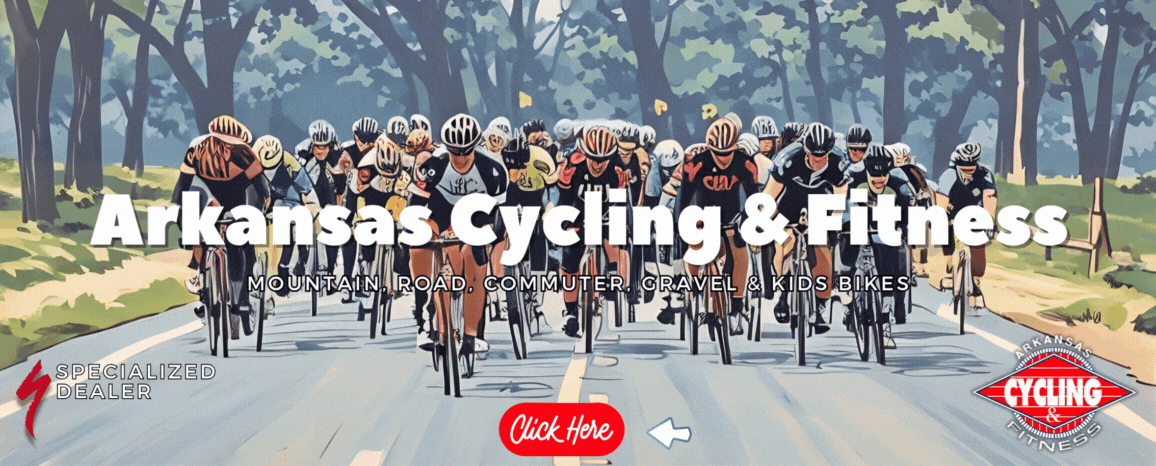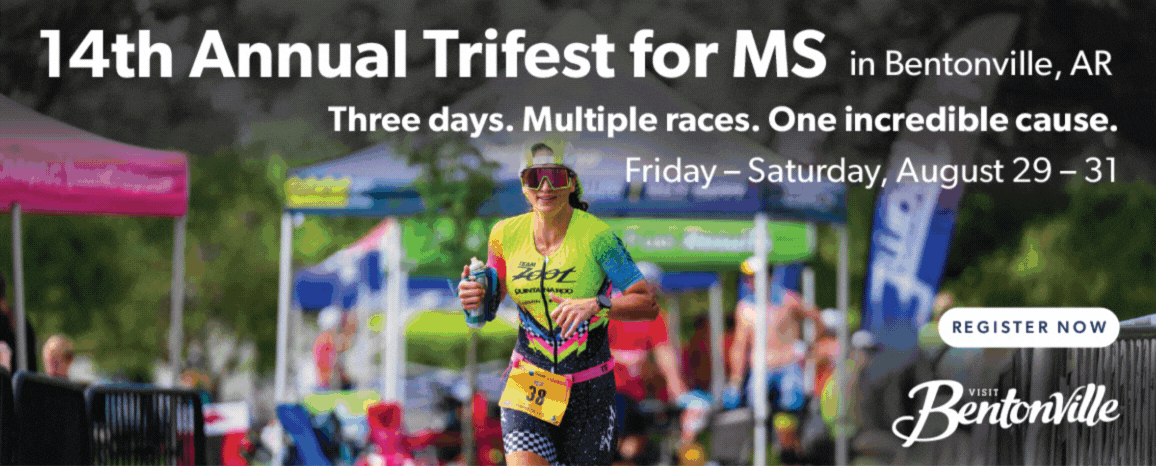Few things spark controversy among trail maintenance organizations like broaching the subject of blowing leaves off hiking and mountain biking trails. As predictable as the change of seasons, each Autumn I can count on various Facebook feeds, chat rooms and discussions over beers at the local brewery turning to should you or shouldn’t you blow leaves off the trails? My initial answer to the question is definitive, “It depends.”

The Pros
Arkansas gets a pretty heavy-duty leaf fall each year from pine in the lower elevations of the southern part of the state to the various oak, birch, hickory, and walnut as well as others of the highlands. Blowing the leaves off the trails can create an easy-to-see trail through the woods making it harder to get lost. It exposes roots and rocks that could be trip hazards to hikers and trail runners and allow mountain bikers to easily navigate better lines and ride faster. These are generally short-lived benefits particularly if blowing is done earlier in the season before all the leaves have fallen. Either way, it’s generally not necessary on a well-trafficked trail as the process of hiking and cycling tends to pack them down and move them although to a less severe degree.
The Cons
- Blowing leaves can leave a trail “unprotected” as this video from New Jersey illustrates very well. While Arkansas does not have as intense a Winter as New Jersey, I’m sure most cold-weather trail users in Arkansas have seen the issues with “frost heave” on the trails as seen in the video.
- Another issue is that under dry conditions, most backpack blowers are capable of not only removing the leaves from the trail but also the precious dirt that lies between rocks and roots. By removing this fine dirt the leaf blowing inadvertently exposes more of the rock and roots above the dirt level (in actuality, dropping the dirt level while leaving the rocks and roots). This creates a rougher trail by further degrading it.
- Finally, under moderate rainfall, leaves protect the trail from direct water giving time for the dirt under the leaves to gradually absorb much of the water before it can run down the trail creating ruts and mud holes.
So What’s the Answer?
Occasionally blowing leaves off the trail is not a horrible thing. I’m a proponent of doing it for events like trail runs where hidden obstacles can be dangerous, but even on these occasions, it may be time to talk to the event organizer if there might be a better time for doing the event. Maybe even blowing the leaves back on the trail when the event is over is appropriate.
Here are some tips if you are going to do some leaf blowing
- Remember that if you are going to be blowing leaves off the trail, do not leave a wall of leaves along the edge of the trail, this can cause water to channel on the trail and degrade it through erosion.
- Don’t try to get every, single leaf off the trail, get enough off to expose hazards, but those new backpack blowers are strong and if you point it in the dirt, it will move the dirt.
- Only blow those areas where it is really necessary. A hard pack dirt section of a trail lacking rock and root hazards doesn’t need the blowing.
- Don’t blow during dry conditions. When the dirt is dry, it’s lighter and thus more prone to flying away with the leaves. A good rule of thumb is if any counties in your area are under a burn ban, don’t blow trails. (probably a good idea to keep the use of gas-powered equipment out of burn ban areas, too) Check for local burn bans here.
Charles Williams, the Trail Adoption Coordinator for Friends of Arkansas Singletrack in Northwest Arkansas, did an experiment on this:
I raked a 100-yard section right out of the trail on SBAT and Moonshiner’s Holler on the Back 40 system. Same exact trail surface, backslope, etc. And I monitored it all winter. Folks….there’s NO argument to be made, the sections that had leaf cover….held up MUCH better. It wasn’t even close in fact, DESPITE me wanting it to be the opposite result!
Leaving the leaves on the singletrack XC trails will go much further toward having a place to ride when we start encountering freeze/thaw, than blowing them. I proved it to myself.
The leaves help insulate the ground from the ambient air temps. It allows the ground temp to be nearer the surface (which in AR remains just under 60* most of the year…think of caves), so when it does get below freezing, it can’t freeze as deeply into the topsoil layer. It’s the deeper freezes that expand the soil and create the mushy peanut butter surface. Limit those…and the trails just hold up better over the long run.But…you could literally ride down those sections and have soft trail where it was clear, and firm trail where the leaves were. It seems like the leaves would hold moisture, and make it worse…but they don’t.
On flow trails where speed is needed…blow the leaves. BUT…just be aware that if we get a good freeze-thaw cycle going, we have to concede that they may be closed for weeks at a time given the right circumstances. We can’t have knuckleheads out there rutting them up. WHICH IS WHY I think it’s critical that we leave the XC trails alone, so it helps us to have a place to ride and to guide tourists toward!
None of that precludes the possibility that we have a long enough cold spell with enough moisture to still have a cycle on ALL of the trails because we saw that 3-4 years ago. But…the leaves help!
My final word would be to assess the trail needs and put aside your own riding or running comfort for the long-term sustainability of the trail. Ask yourself if what you are doing is for the benefit of the trail. Are you sacrificing years of riding a great trail for a couple of months of clean, highly visible trail? Should you leaf blow the trail, well, it depends.







7 Responses
While I agree with not blowing when it too dry, that would be the one ofonly time. Leaves are organic matter and not a suitable trail surface, they will compost and leave a slick surface in the spring, almost as bad as putting logs in a mud hole. Unless you have very rocky trails and want something to hold them together. Frost heave will be greater in organic soils a you should consider reroute and not depend to have leaves protect your trails. The clay we have drys much better without the leaves holding moisture in. The soil you’re concerned about losing by blowing is most likely organic, something you don’t want on a trail. All the pictures I’ve seen of frost heave and it erosion have been in organic soil and poor trail design. You should fix the problem, not cover it up.
The mantra of trail maintenance is to keep people on the trail and keep water off of it. Layers of leaves on the trail don’t help either of these two tenets. Leaves hold water on the trail. Hikers, runners, and bikers who don’t want to step in water or mud, or don’t want to get mud in their bike’s expensive derailleur systems, either wait until a trail is completely dry (the right thing to do, but not likely) or go around the wet areas. The more they go around wet areas the wider the trail becomes and the more erosion occurs. Additionally, some of the leaves tend to bunch up on the lower side of the trail creating a berm which turns the trail into a ditch–leading to more erosion as water starts running down the trail. The best thing to do is to maintain a trail to its design specifications with the appropriate out slope, back slope, and tread width so the water will sheet off the trail. If you do that, trails will dry much faster and you will be able to get out there and enjoy nature without injuring it. There are numerous trail construction and maintenance resources out there from IMBA, USFS, the Appalachian Mountain Club, the Student Conservation Association, and many others. To the best of my knowledge, none of them say “build or maintain a trail that will stay wet longer.” Enjoy the great trail system we have in Arkansas and set aside a little time to put some sweat equity into maintaining trails so future generations will be able to enjoy them as well.
Bert, as an avid hiker, mountain biker and trail builder who lives preaches the tenets of sustainable trails, I find your initial assumption off. I don’t believe leaves “hold water” on the trail. Instead, they allow sheeting that doesn’t move dirt from the trail. I will guarantee that 200+ mph winds applied directly to the trail will remove dirt from between roots and rocks, I’ve also never seen this recommended by IMBA, USFS, the Appalachian Mountain Club, or the Student Conservation Association. I will even predict that if the new trails at Burns Park, which are currently nice and smooth, are blown on a regular basis, within a few years they will look exactly like the rest of the rock garden of trails at Burns Park. I recently rode Boyle Park. Someone had blown off about half the trail. Leaves were piled on the sides where they will channel water down the trail. On the sections not blown, the trail tread was protected. Since the trail is getting ridden on a regular basis it was still easy to follow. There was absolutely no need to degrade the trail by exposing the dirt to the elements and the wind from a backpack blower.
I do believe that there are times when blowing trail is necessary but only sections where trail degradation is kept to a minimum, for doing initial leaf removal for trail building, and when done properly as spelled out in the article. I’d love to convince all trail stewards of this.
There are smooth trails at Burns park?
Seriously, I hate rocky rooty trails. If leaving the leaves makes the trails smoother then we should leave them. Maybe go the opposite direction, lets add leaf mulch onto the trails. Over time as it’s tamped down it will develop into a nice bed and stable trail. I’m not helping here…
Id do see the point Joe, and have to agree. While leaf blown trails are very pretty, we are really trying to control a natural phenomenon that truly helps the trail in the long run by removing leaves and other materials from the trail. Let it be a trail not a manicured yard path.
The one case where I find leaves bad enough to want them removed is when a trail is cut into a hillside. Sometimes, the leaves fill the cutout to the point that you can no longer see the lay of the trail. In this situation, a tire will often run outside of the cutout, causing it to slide and– usually– cause the cyclist to crash.
That said, wind erosion is still erosion.
Leaves are a natural part of the area. Hikers, riders and horse-persons might want to consider learning to navigate within them. This builds skills, particularly for riders. Some trails are more challenging than others. Paved or crushed-gravel trails may be a better choice for users who cannot navigate leaf-covered singletrack.
Blowing trail should only be done for building new trail where the trail needs to be cleared of small trees and bushes. In specific areas where leaves are very deep or cause the trail to be hard to follow an old fashioned rake should be used. Try one, much better for the environment than a polluting and noisy blower.